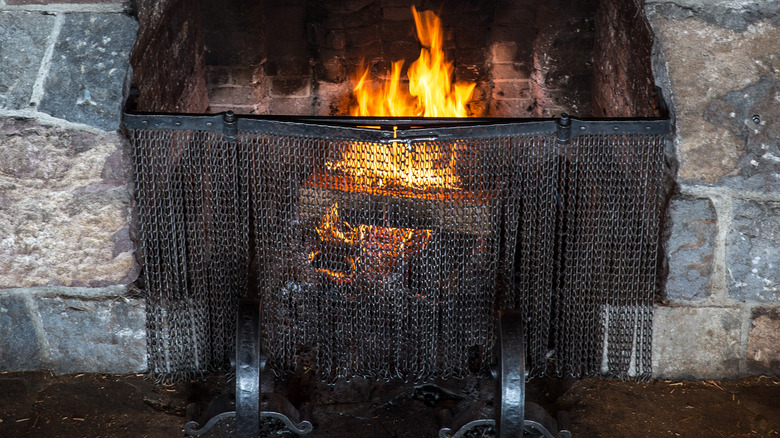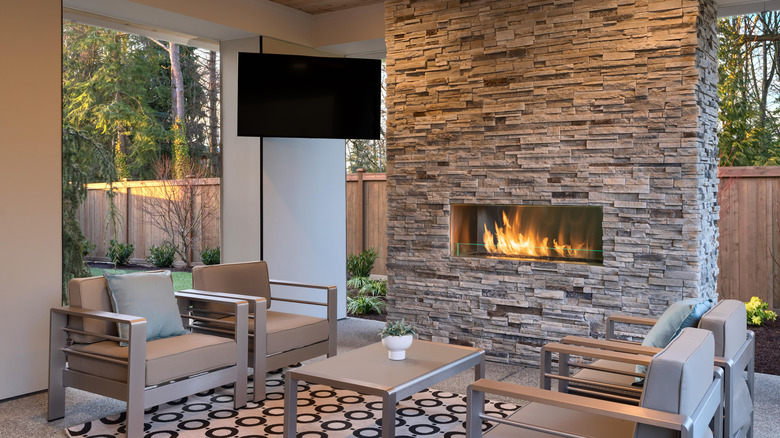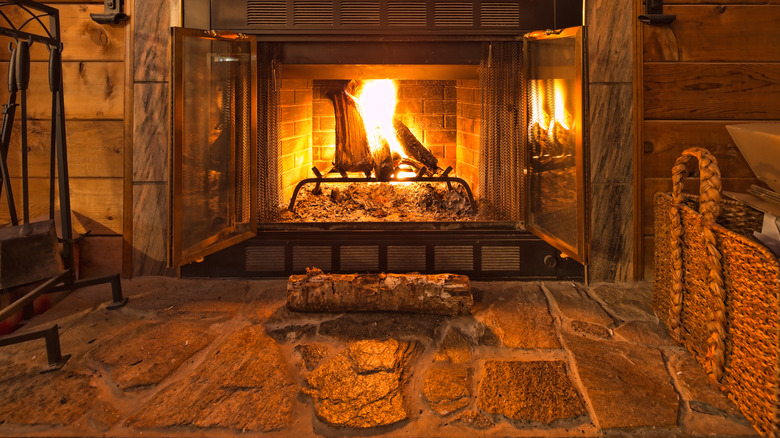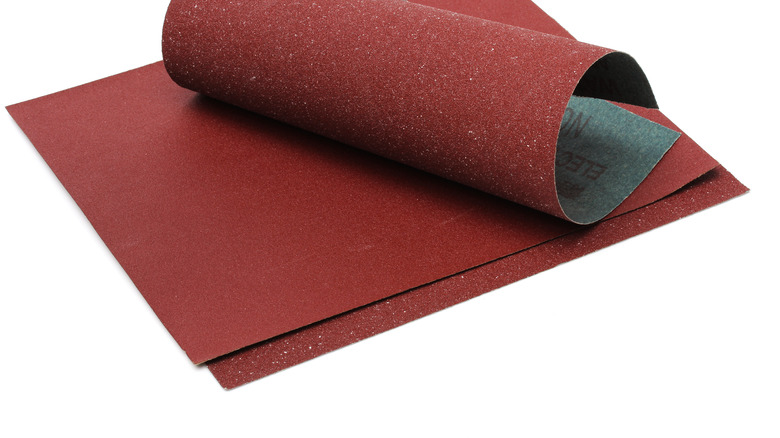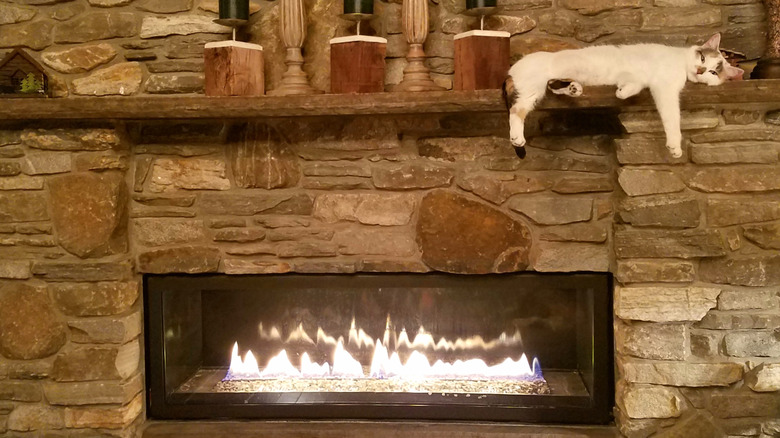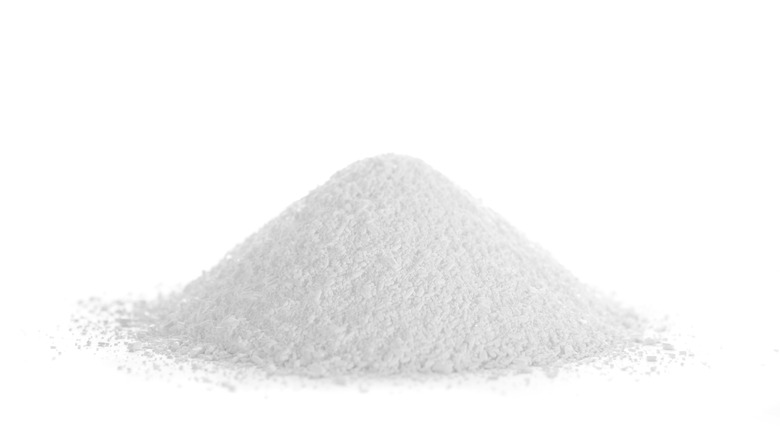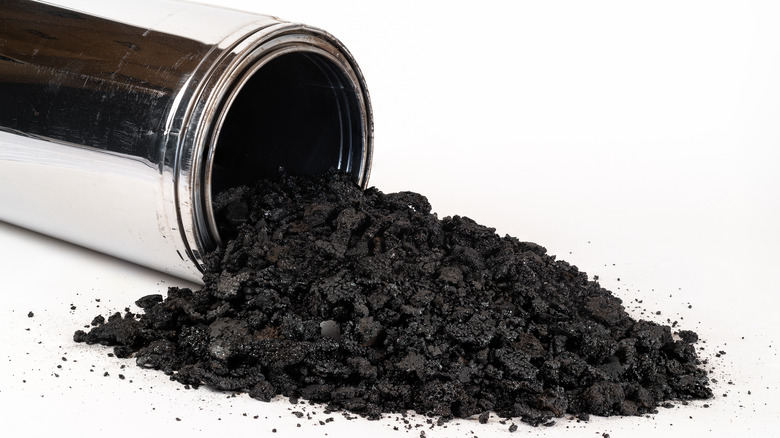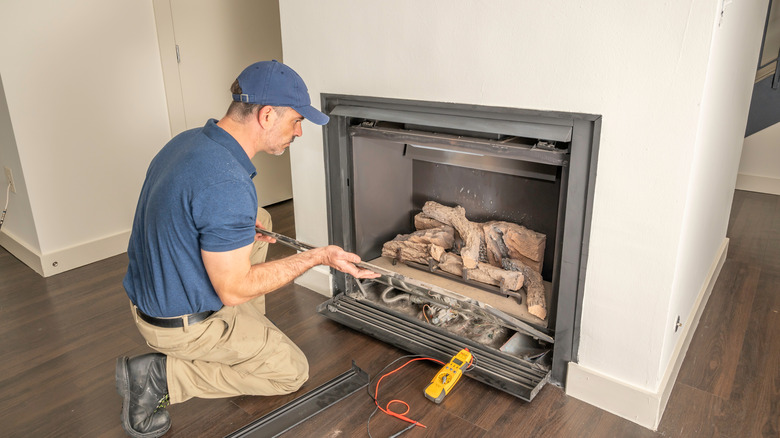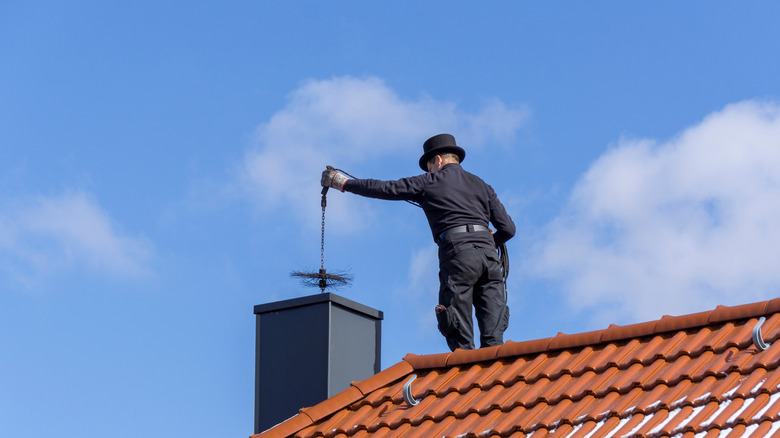8 Easiest Ways To Clean Stone Fireplaces
A fireplace adds so much to a home. Once an important cooking and heating element in pre-electric houses, it now offers a dwelling a calming, inviting atmosphere. Typically made of masonry, a hearth casts a warm glow, imbuing the room with its lovely flickers of red, orange, and yellow. Besides ambience, a fireplace can add to a house's resale value by 6% to 12%, according to the National Association of Real Estate Appraisers, quoted by Kozy Heat.
You need to treat that stone fireplace with care, though, to receive those long-term benefits. You'd figure that rocks could stand up to anything done to them, but over time the porous surface of the stone erodes if you use abrasive products for cleaning, said ELB Fireplaces. Cleaning this space weekly prevents a build-up of ashes and refuse, according to The Maids, but wait until 12 to 24 hours after using it to address the mess.
The best way to rid yourself of that blackened soot, grimy dust, water stains, food spills, etc. is actually simpler than you think. Most of the time, you can use homemade or readily available cleansers and an assortment of brushes and/or sponges. A little scrubbing later ... and voilà, a sparkling clean fireplace. Make sure that you prep before beginning the work; you'll want to protect your furniture with tarps, and put on a dust mask and gloves so none of that dust in the air gets into any unintended place (via Bob Vila).
1. Remove ashes and dust regularly
If you are using your fireplace on a regular basis, it is important to remove any burned waste. Not only will it make the space look better, but that build-up can hurt your health since burning wood releases air pollutants like toxins, according to the American Heart Society, and its remains can sit in your hearth for weeks if unaddressed.
Weekly cleaning of debris is advisable, according to The Maids, who recommended sweeping up ashes and unburned wood chunks and then sprinkling slightly wet coffee grounds on them before removing. This keeps the often-light soot from flying around on your carpet and furniture — and avoids taking out the vacuum to clean them! Bob Vila also suggested putting ashes into a metal container and then adding cold water to it before attaching the lid. This way nothing that's still flammable ignites. Never remove any burning ash. This is dangerous — besides damaging to furniture, rugs, etc. — you can easily start a fire or burn someone. Never clean soot unless at least half a day (or more) has passed since your last fire.
2. Clean the stone bricks with gentle remedies
Natural stone for fireplaces varies from granite (super durable) to more porous versions like limestone and sandstone, said the Chicago Tribune. But you can clean both with some DIY techniques. Namely, try cleaning the stones with warm water and a rag then let dry. If marks remain, grab a spray bottle filled with hottish H2O, and wet down the area before lightly scrubbing it with a brush. Let this dry and blot away any excess liquid.
For stubborn stains you can also try adding several tablespoons of dish soap and then re-scrub the space. You can opt for household cleaners, too. Just be wary when using anything that has bleach, acids (including vinegar), or trisodium phosphate (TSP). These are quite harsh and without care can damage your stone. The DIY Network also suggested always testing out your cleaning solution before applying it all over. Find a small, out-of-the-way spot and create a sample site, then clean and let dry. If nothing seems lightened or streaked, you are good to go.
3. Sand out super stubborn stains on the stones
Sometimes no matter how much you scrub, some blemishes won't come out. If your fireplace's stone is soft (like limestone), you can try sanding the stain away, according to the Chicago Tribune. You'll need fine- to medium-grit sandpaper (120- to 80-grit) for the job and a vacuum cleaner to eradicate the mess you will make — on the stone and on your floor.
Remember that this requires a light touch, as you are actually sanding off part of the fireplace's surface; you cannot put back anything taken off. Try following the stone's contour and texture when possible. Some stone is so smooth, you won't see any. Gently sand the area, wipe it clean with a rag, and then vacuum the area to remove all signs of sanding. How does it look? Hopefully, the mark is gone, and you can just straighten up the area. If the discoloration still exists, keep in mind that ash, sparks, and dust do leave their mark and even the most fastidious tidier might have a fireplace with the occasional usage scar.
4. Make that mantle sparkle
Take proper precautions when cleaning up the mantle, advised SF Gate; you want to ensure that your scrubbing doesn't damage the walls or floor. So use painter's tape to protect all these areas from any cleanser splashes. You might also want to put a tarp on the floor or cover nearby furniture. You also want to use similar cleansers as the ones used for the stones, starting with milder versions containing dish-washing detergent (3 parts water to 1 part dish cleanser). Tougher stains might require that you mix 10 parts water to 1 part hydrochloric acid with a few squirts of detergent for good measure. Rinse immediately after gently washing.
A good idea is to presoak the mantle before cleaning other sections of the fireplace — especially if you are using a more corrosive method of removing dirt. Take a sponge and mop the area with H2O. You can dab it again if your work takes long enough that the moisture dries.
5. Bring in tougher cleansers for more resistant marks
You've used the dish soap, and the time has come for something with a little more juice to it. Before bringing out the big guns, Do It Yourself suggested mixing 1 cup of detergent and 3 tablespoons of table salt with 3 quarts of warm water. Protect yourself with rubber gloves and apply for 10 minutes. Then grab a plastic wire scrubber and gently hit all that dirty grout and stone (a toothbrush works well for any hard-to-get areas). Use a sponge and water to remove; rinse as much as you need to assure just the stone remains.
What?! The stain persists? Try some ammonia, something that has 5% to 10% of the substance. Mix 1 cup with a pound of finely ground pumice, and add water to make a paste. Put on the fireplace for 10 minutes and then repeat the pattern of scrub/rinse. You might want to add long sleeves and goggles for protection because ammonia can burn and sting if it touches you. If that doesn't work, try a harsher cleaner like trisodium phosphate. Put 1/2 cup of TSP to 3 quarts of water. This is toxic so bring out all the safety wear, from a face mask to gloves to goggles.
6. Eliminate any creosote deposits
Any fireplace used eventually gets some creosote coating — a fire byproduct that looks dark brown or blackish and can promote chimney fires — on its stones, said Bob Vila. You probably can should address this annually. Those of you who use the fireplace as a room accessory — and rarely light it up — have a bit more time between cleanings. When the firebox, the main area where your logs always burn, has about 1/8 inch thick layer of creosote, it's time to eliminate it.
There are three stages of creosote development, according to Priddy Chimney Sweeps. It starts as a small problem with just a thin layer of flaky residue; this is easiest to clean. In the second stage, the creosote begins to look like tar, and it's harder to remove so you might need to call in professional back up. Stage three can cause a fire since it's thicker and starts to restrict airflow. A chimney service might be required to get this residue off.
A DIY remedy for general cleaning is 1 tablespoon of dish soap to 4 cups of hot water, according to Hunker. For most of the fireplace, just washing to stones down might fix the situation. If you're working on the chimney, it might merit more tools, such as a sharp blade, to chip away the thicker layers.
7. Scrubbing stone gas fireplace tips
Stone gas fireplaces may keep you away from the woodpile, but they also need a regular cleaning. Burners can clog and the logs, while designed for long-term use might need a touch-up or a replacement, said Fireplaces Direct. The glass often becomes cloudy as well. To address any issues, turn the pilot light off and touch the fireplace only after it is completely cool. Look in the manual to understand how to dissemble all of the fireplace's components so you can make everything immaculate, said The Spruce. It's also a good idea to take whatever you can outside to work on — and avoid creating a mess inside.
You'll want to remove the glass and polish it with glass cleaner. The thermocouple, the devise that measures temperature, also gains soot over time. Fix this issue by turning off the power and eliminate any dirt with steel wool or emery cloth sandpaper. Wire brushes and coarse tools can hurt the thermocouple. When the buildup dissolves, take a soft cloth and go over all of your work. When everything looks tidy, reassemble your fireplace.
8. Get a regular chimney check
You want to ensure that your fireplace's chimney functions properly, which is why you want to opt for a yearly check-up, according to the Chimney Safety Institute of America (CSIA), with an inspection and cleaning. You want to ensure that nothing is blocked or broken so overheating or a fire never happens.
Of course, for the DIY'ers you can clean the chimney yourself by purchasing a sweeping brush, and then sealing your fireplace tightly with plastic so it catches all the soot coming down. Now here's the hard part: You'll need to go the roof and remove the chimney cap. Inspect your chimney liner — are there any tears? — then look an see if anything is obstructing the shaft. Do your cleaning with a respirator, safety goggles, and gloves. Make sure to remove all soot, dirt, and creosote. Not everybody wants to do this job, so if you like to stay away from the roof just hire a service, per Mr. Fix It DIY.
